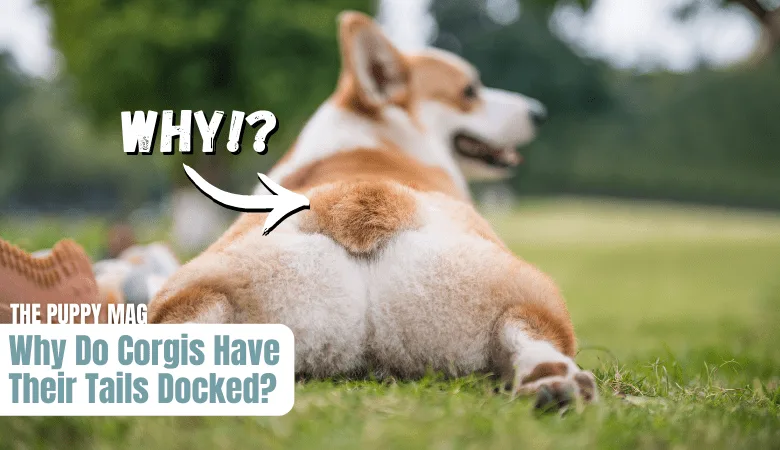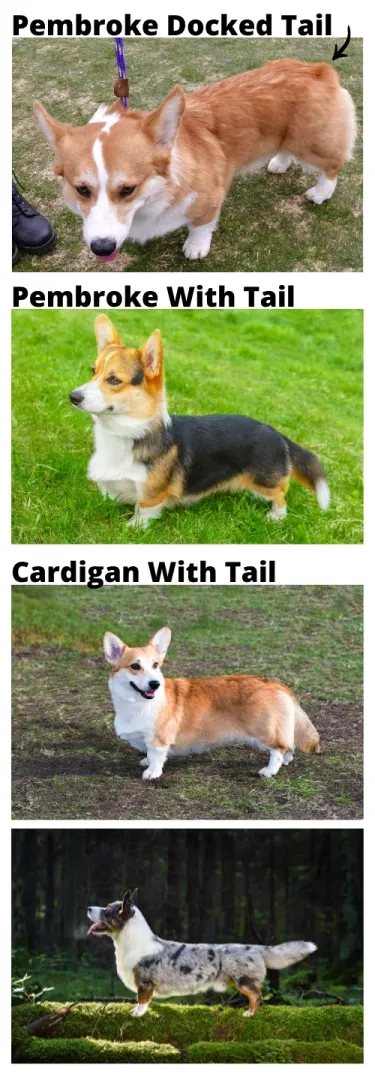Do corgis have tails…? 🤔
It’s a great question and it seems like it’s getting harder to come by corgis with tails nowadays. So why is it that so many get their tails docked?
Since we receive many owners asking these questions, we’ve created this guide covering everything you need to know about corgi tails and docking.
Tail docking is done primarily with Pembroke corgis, not Cardigan corgis. And the main reason is to follow breed standards and fall in line with traditional looks.
This is why there is some confusion about corgis and tail docking, sometimes you see corgis with tails, and sometimes you see them without.
A long time ago, tail docking was thought to prevent rabies and improve speed, but we know now that it doesn’t help with either of those.

Table of Contents
Do Corgis Have Tails?
Yes, all corgis naturally have tails and are born with them.
The reason you see so many corgis with short little stumps instead of a tail, is due to having their tail docked 3-5 days after birth.
However, if you notice, it’s nearly always the Pembrokes that have their tail docked, NOT Cardigans.
Many Cardigans keep their natural tails while most Pembrokes get the chop.
Still, some Cardigans have their tails docked too.
It’s likely down to this procedure being done so soon after birth, that leads many people to wonder whether corgis have tails in the first place.
Let’s explain tail docking and all the FAQs below!
What Is Tail Docking?
Before getting into the reasons behind tail docking in corgis, it’s best we cover the basics and explain precisely what tail docking is.
Tail docking is a surgical procedure that involves shortening or “docking” a puppy’s tail. The tail is not entirely removed but rather cut down to a very short length (2-4 Inches).
After the procedure, the tail will not grow bigger.
1. When is tail docking carried out?
Tail docking is generally carried out from 3 to 5 days after birth.
2. Who performs the procedure?
Breeders or veterinarians will be the ones to perform tail docking procedures.
3. Can older dogs have their tails docked?
Older dogs can get their tails docked, but this is then considered a standard surgical procedure and an anesthetic will be used.
4. Does tail docking hurt the puppy?
This is where tail docking gets controversial, so let’s explain this. First of all, you should know that typically, no anesthetic is given for this procedure.
And the reason tail docking is carried out just a few days after birth is that it is said to not cause the puppy any pain (or limited pain) due to their nervous system not yet being developed.
The big issue, however, is that their nervous system is, in fact, developed enough to feel pain. Many highly qualified veterinarians and scientists explain that puppies do in fact feel the procedure (without any anesthetic!).
Obviously, this is therefore excruciatingly painful, and many consider it to be cruel.
In addition to the pain issue, many believe that tail docking is completely unnecessary anyway. Apart from a small number of medical reasons, there is no need for any dog’s tail to be cut short as it doesn’t benefit them in any way, but I’ll elaborate on this in the coming sections.
5. Is tail docking allowed legal?
Tail docking might soon be a thing of the past because more and more countries are banning it. Evidence to support that tail docking is “cruel” and “unnecessary” comes from the fact that many countries have already completely banned the procedure. Australia, the UK, Europe, and recently all VCA Hospitals in Canada have banned cosmetic procedures like tail docking entirely. Tail docking is still currently allowed in the USA.
4 Reasons Why Corgis Have Their Tails Docked
So let’s explain the reasons behind why corgis have their tails docked in the first place. It boils down to three historical reasons and one primary reason that’s relevant today.
➡️ Improved hygiene
➡️ Improved performance
➡️ Injury prevention
➡️ Conforming to breed standard
1. Improved Hygiene
Tail docking actually has a very long history. It’s said that during ancient Roman times, dogs started to have their tails cropped for various reasons including hygiene.
Ancient Romans believed that dogs with long tails were more likely to catch rabies, and so to offer the dogs protection they started snipping their tails back.
2. Improved Performance
In addition to hygiene, it was soon thought that a shorter tail equaled an increase in speed and performance.
Dogs were almost solely used for working purposes back in Ancient Roman times and so a faster dog was always preferred.
Due to this, tail docking continued for a very long time.
3. Injury Prevention
Another reason that came, later on, is that tail docking helped prevent the dog from getting injuries while out hunting and retrieving in the fields.
It was thought that long bushy tails attracted foxtails (speargrass) and burrs, both of which can cause injury or pose a risk to the dog.
Any dogs that became injured or unable to work were no longer considered useful to the farmers.
4. Confirming To Breed Standards
All of the reasons above are pretty much redundant now. Tail docking did not prove to prevent rabies, it didn’t make the dogs faster, and injury prevention wasn’t really measurable.
Besides, most corgis are not out working in fields every day anymore…
The real reason that tail docking still happens today is for cosmetic purposes (aesthetics) or in other words, conforming to the breed standard or “norms”.
If you ask the average person what a corgi looks like, most will cite them as having a short stubby tail (just like boxer dogs).
This has actually lead breeders wanting to keep the “traditional” look of the corgi to ensure they are still able to sell them. It’s simply what people “expect” a corgi to look like.
In addition to this, Pembroke corgis that compete in dog shows must have a docked tail to conform to breed “standards”.
Unfortunately, this is another reason why tail docking continues to happen for cosmetic purposes. For Cardigans, this isn’t the case (as explained above).

Psst. A quick Corgi update! Brain Training For Dogs might now be one of the best training methods suitable for your Corgi. Owners are seeing improvement in obedience, behavior, and stubbornness quicker than ever before. Okay back to the post!
Pembroke vs Cardigan Tail Differences
Let’s also clarify the difference between the two corgis and their tails.
● Pembroke Welsh corgis almost always have their tails docked. (location dependent)
● Cardigan Welsh corgis do not always have their tails docked. (some still do)
Why is this?
The likely reason is that according to the American Kennel Club (AKC).
Pembrokes must have docked tails in order to conform to the breed standard, but Cardigans do not.
For Cardigans, there is no mention that the tail must be docked, in fact, full-length tails meet the breed standard as long as they adhere to specific criteria.
Breed Standards:
AKC standard for Pembrokes: “Docked as short as possible without being indented. Occasionally a puppy is born with a natural dock, which if sufficiently short, is acceptable. A tail up to two inches in length is allowed, but if carried high tends to spoil the contour of the topline.” Source
AKC standard for Cardigans: “Set fairly low on body line and reaching well below hock. Carried low when standing or moving slowly, streaming out parallel to ground when at a dead run, lifted when excited, but never curled over the back. High tail set is a serious fault.” Source
Due to this, A LOT more Pembrokes have their tails docked, than Cardigans do.
Corgis With Tails – Images
It turns out, we still haven’t found a good image of a Cardigan with a docked tail! This goes to show that many do in fact keep their tail.

Are Corgis Born Without Tails?
Although extremely rare, some corgis are born with a naturally docked tail or no tail at all. Naturally short tails are called “bobtails” which means they only have 1 or 2 vertebrae. This can also happen in a lot of other breeds.
In many cases, it’s hard to tell the difference between a natural bobtail and a surgically docked tail.
And depending on the length of the bobtail, some corgis may still need to have them docked further if they want to adhere to breed standards!
The cause of natural bobtails is actually a gene mutation known as the C189G gene. This can be passed down through generations to any corgi.
One thing that’s very important to know is that bobtail corgis should never be bred with other bobtails. This can result in devastating abnormalities and health conditions such as spina bifida or other spinal defects.
In many bobtail-bobtail litters, puppies are euthanized due to having such severe issues.
This is why is extremely important that we do not breed bobtails with other bobtails (accidentally or otherwise).
Do All Corgis Have Docked Tails?
No, not all corgis will have their tails docked. First, it depends on location, as many countries have made tail docking illegal.
Secondly, Cardigans don’t need to have their tails docked to conform to breed standards, so most Cardigans keep their fluffy tails.
More and more corgis are finding themselves with their tails intact, and personally, I think that’s a great thing.
As time goes on, fewer corgis will find themselves having docked tails, as the practice is generally fading out. But as we all know, traditions don’t die easily…
Pros & Cons of Tail Docking In Corgis 👍👎
Let’s run through some of the pros and cons of tail docking in corgis. In my opinion, there aren’t really any pros, but in an effort to remain fair, I’ll cover everything that others might consider a “pro”.
Pros of tail docking:
✅ Improved hygiene:
Potential pros of tail include improved hygiene. Some corgis have very fluffy tails which can drag through all kinds of muck and bacteria when outside. Docked tails of course don’t get dirty at all! So there’s that.
✅ Preventing certain injuries:
In some breeds, there’s such a thing known as “happy tail” this is a condition that’s primarily caused by the tail repetitively hitting hard surfaces. This, however, is more common in larger breeds with stronger tails. Corgis likely couldn’t generate enough force with their small body and tails to do themselves any damage.
✅ Adheres to AKC breed standard:
If you have a Pembroke corgi and you want to enter show dog competitions then having a docked tail is a requirement. Although for Cardigans, this isn’t the case.
Cons of tail docking:
❌ Considered cruel and painful:
Veterinarians have cleared the myth that a puppy’s nervous system “isn’t developed enough to feel pain”. It certainly is, and therefore tail docking is an extremely painful procedure that no puppy should have to go through.
❌ Impaired social skills:
Dogs use their tails as a social signal to other dogs that may be approaching. A lack of tail adds an extra layer of difficulty for some dogs getting along with others. This may sound silly, but it’s incredibly important, especially for early socialization purposes.
❌ Chronic pain:
In very unfortunate circumstances, some corgis can develop long-lasting pain from the procedure. This could be caused by general nerve sensitivity in the area or secondary nerve spinal tumors.
❌ Incontinence:
Although incredibly rare, in some cases, tail docking can negatively impact a puppy’s ability to hold their bladder. This has knock-off effects resulting in incontinence later down the line.
❌ AVMA is against tail docking:
Last but not least, the American Veterinary Medical Association is against tail docking. Although in the USA tail docking is still allowed by law, the AVMA strongly opposes it and describes it as an unnecessary procedure due to the pain with unclear benefits.
The AVMA is a well-respected organization and if they strongly oppose something animal-related, we should all listen.
Should You Dock Your Corgis Tail?
I also receive this question a surprising amount, so I’ll give my take on it.
Ultimately, the decision is entirely up to you, providing you do actually live in a country where tail docking isn’t banned by law.
But, I would encourage everyone to think twice about such procedures.
Unless you intend on being someone who enters their dogs into competitions then it’s absolutely not necessary to have their tail docked.
And the whole topic of show dog competitions and “breed standards” is another hotly debated topic in and of itself! But ill leave that for another day…
Personally, I do not recommend it and find it be cruel and unnecessary along with practically all other veterinarians and most breeders.
But that’s just my opinion. If you are interested in something like this, then that’s a personal choice but I would strongly consider the ethics of it, and consult your veterinarian beforehand.
Oh, and if you are like many that are on the waiting list for a corgi, be sure to inform the breeder that you do not require their tails to be docked, otherwise the breeder may take it upon themselves to do it anyway. Especially with Pembrokes.
Thank you for reading! Back to more Corgi articles >
Most Recommended For Corgis
Best Brushes For Shedding
To maintain your corgi’s shedding, you’ll need a regular brushing routine and the right kind of brushes. A simple Undercoat Rake and a Slicker Brush are by far the two best brushes to keep the hairs at bay.
Best Online Training Program
Brain Training For Dogs has become increasingly popular with working dogs in the last few years and is now recognized as one of the best ways to train dogs in the most stress-free, positive way.
Best Low-Calorie Treats
Keep your corgi at the correct weight by switching out the high-calorie treats and opting for something healthier. Zuke’s Mini Naturals contain only 2 calories per treat and are made from natural ingredients, making these some of the healthiest treats on the market.
